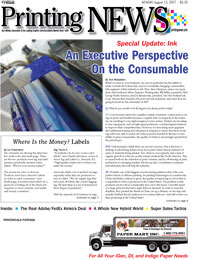|
  Aug. 13, 2007—When it comes to your business, one area in particular has the ability to make or break the bottom line, and it is constantly changing: consumables. One segment of that industry is ink. Here, Steve Simpson, senior vice president, chief technical officer, Superior Printing Inks; Bill Miller, president, Flint Group North America; and Joe Bendowski, president, Van Son Holland Ink Corp. discuss their business, the print and ink industries, and what they see going forward for the remainder of 2007. Aug. 13, 2007—When it comes to your business, one area in particular has the ability to make or break the bottom line, and it is constantly changing: consumables. One segment of that industry is ink. Here, Steve Simpson, senior vice president, chief technical officer, Superior Printing Inks; Bill Miller, president, Flint Group North America; and Joe Bendowski, president, Van Son Holland Ink Corp. discuss their business, the print and ink industries, and what they see going forward for the remainder of 2007.
Q: What do you consider to be the biggest issue facing printers today?
SS: Cost increases driven by variables outside of printers' control such as rising oil prices and health insurance, coupled with overcapacity in the industry, are resulting in very tight margins in some sectors. Printers are investing in new equipment, such as high-speed perfectors, or technological solutions to improve their competitiveness. However, it is becoming more apparent that additional training and education is required to insure that those working with it are able to realize all of the economic benefits in the face of variability in press consumables, the quality of which is increasingly specified by the print buyer.
BM: Unfortunately, I think there are several concerns. One is the loss or shifting of advertising dollars away from print, which means reduced volumes of materials being printed. Two, there is over-capacity, and a lack of organic growth in what are mostly mature markets like North America. This is caused both by the reduction in print volumes, and by off-shoring of print production to emerging markets. On the up side, consolidation continues and ultimately this will help the industry.
JB: Probably one of the biggest concerns facing printers today is the competitive threat of offshore printing. As printing technologies in countries like China and India continue to grow, the quality is improving to a level that is comparable to what is produced in the United States. The problem is that products can be sold at considerably less cost to the buyer. I recently heard of a large print job that had a tight delivery demand. In order to meet the deadline, they printed the sheets in China, set up a bindery on the ship and actually finished the job underway for on-time delivery—and still at less cost than producing in the United States.
Q: How do ink manufacturers affect that?
SS: Our products are being continually refined and often reengineered to improve their versatility for a wider range of papers and other consumables. Most recently we have been examining novel ink drying mechanisms, which will allow our customers to maximize the productivity gains from high-speed perfectors.
BM: We can have very little affect on improving the situation. In fact, we ourselves are affected just as our customers are.
JB: Although ink is a small portion of printing expense, the only thing manufacturers can do to help is to try to keep the price of ink under control. This is difficult with the ever-increasing costs of raw materials, labor, and other expenses.
Q: What are the biggest changes to the ink industry over the last five years?
SS: As the ink industry giants struggle with commoditized markets, the specialized or niche companies have remained focused on the evolving needs of their customers. By doing this, we have made a conscious decision to retain core expertise critical to providing the best portfolio of products and services of value to our customers. We also retain our agility, and our strong relationships with suppliers allows us to bring new technology and producs to our customers more quickly.
BM: Globalization. It has changed the competitive landscape as offshore manufacturers have entered the domestic market. More importantly, the rising demand for raw materials in emerging markets has affected sourcing, availability, and cost of the materials we use in inks.
JB: The rising cost of petroleum-based ingredients has caused an unusual number of price increases. This was further magnified by increased cost and shorter supplies of pigments. Consolidations, mergers, and acquisitions between manufacturers have added further confusion.
Q: What changes do you think will have the biggest impact on ink in the next five years?
SS: Within the sheetfed market, ink will continue to be driven by press developments, which will continue to focus on simplified operability and higher output. Technology will drive the market.
BM: As global demand increases, the price and availability of raw materials could impact our industry still further.
JB: Domestic ink manufacturers will face similar pricing pressures from offshore suppliers as printers do. Raw materials will continue to shrink in supply, adding further pressure.
Q: What can you advise printers regarding ink?
SS: Never be afraid to involve your ink supplier in recommending ways to improve processes, from bindery issues to color management concerns. We are always willing to share our experiences to improve your profitability.
BM: Be sure you are working with a supplier that has the capabilities to assure continued quality in this volatile, fast-changing raw materials market.
JB: When choosing an ink, remember it accounts for about 3 percent of costs associated with print. Do not shop only on price, but rather on performance and quality. The costs of using an underperforming ink exceed any perceived savings.
|


